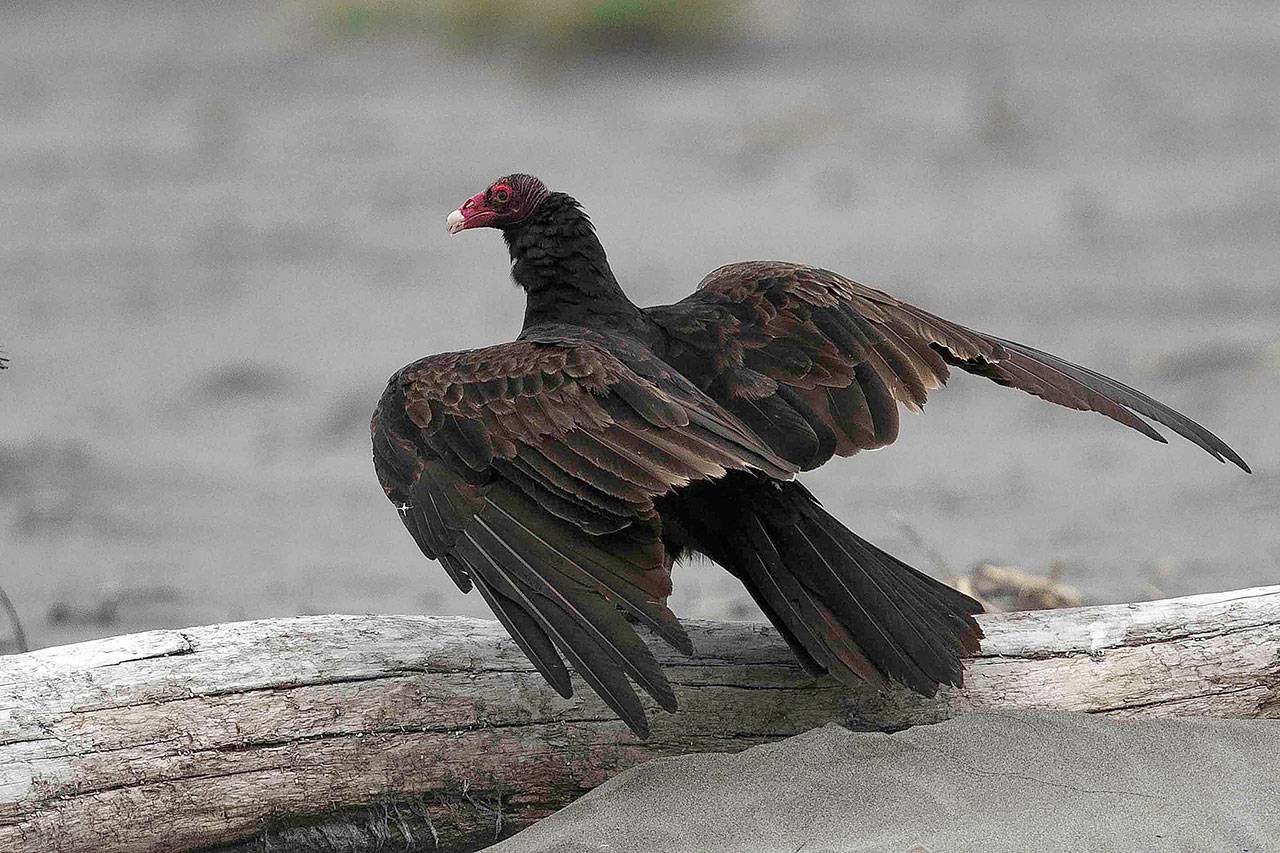By Dianna Moore
Grays Harbor Audubon Society
Known to me as a child as a “buzzard”, the presence of this bird circling above indicates something dead is nearby. If researchers want to capture one they use road kill if possible to lure one in range of their net. So it transpired that our very own Dr. Dan Varland of Hoquiam’s Coastal Raptors found himself hosting some folks from the Hawk Mountain (Pa.) Sanctuary. The plan was to capture four birds and after drawing blood for contaminant testing, measuring and weighing them, then fitting each with a wing tag with an I.D. number on it, a transmitter was also attached. The birds are now being tracked via satellite and can be followed on a web site. One of the birds has been tracked to the Columbia River corridor near I-5 and the other three are staying in the Grays Harbor and Lake Quinault areas.
General Description: Turkey Vultures are a large New World Vulture, featuring dark brownish-black uppers with silvery inner wing/flight feathers and black wing linings. Adults have naked, red heads and a light-colored bill. Juvenile birds have gray heads. They are approximately 25 to 32 inches in length, have a wing span of five to six feet, and weigh about six pounds. Most of their inflight time is spent soaring in wide circles, wings raised in a distinctive dihedral (v-shaped) pattern, and tipping back and forth as they glide, using their powerful sense of smell to find carrion.
Habitat: Turkey Vultures hunt over open country, especially near roads, rocky cliffs, wooded areas, and beaches. The same habitat is used for their nests.
Behavior: These birds soar across their foraging areas, using their powerful sense of smell to track the scent of carrion and scanning for scavengers already on the prey. They may feed alone in place or congregate around the food source. In the Pacific Northwest, they roost communally in small groups.
Diet: Turkey Vultures are scavengers, eating nearly any carrion they find. They cannot open large carcasses, so will concentrate instead on smaller prey or wait for larger predators, such as coyotes, bear, or cougar, to begin the process.
Nesting: Turkey Vultures form long-term pair bonds with ritualized displays consisting of several birds in a circle, with much spreading of wings and hopping into the air. Nests are mere scrapes, located on cliffs, in hollow trees or logs, caves, dense thickets, old buildings, or any secluded spot isolated from people. The female lays one to three eggs, they both incubate them for about 28 days (both have brood patches), then they take turns brooding the young … one finds food and regurgitates it for the young while the other broods. The young begin to fly at about nine weeks of age, with those at a lower nest elevation having the luxury of short, practice flights and those higher up in the air having to take the riskier and longer flights. The youngsters keep close to the nest site for the next few weeks, taking advantage of food drops from their parents.
Migration: Turkey Vultures from Vancouver Island, British Columbia and north gather in a staging area at the southern end of Vancouver Island in late summer then head south across the Strait of Juan de Fuca in groups of up to 400 birds, catching the thermals off the peaks of the Olympic Mountains and the valleys below. They can be found en route to southern California, Mexico, and into South America but it isn’t known where their final destination is. They return to Washington state beginning in February.
Conservation Status: The current status of Turkey Vultures appears to be stable and may even be increasing. They are difficult to track down and count due to their ability to cover lots of territory in a day. Threats to their population come from ingesting lead from gut piles or discarded game, pesticide ingestion from the time they spend in agricultural fields, and collisions with cars. Fortunately much of their earlier persecution has stopped now that we understand their feeding habits.
When and Where to Find on Grays Harbor: My own experience with viewing these birds is along the highways. They seem to be visible almost anywhere between Ocean Shores and Olympia, as well as out in the fields, again viewed from the highway. Most frequently seen above the bluffs on the east end of Aberdeen, out at Grass Creek and around the forests along the highway outside Hoquiam, I can count on at least six or seven birds between Hoquiam and Ocean Shores and the same amount around Montesano and Elma. Watch for those wing tags!


